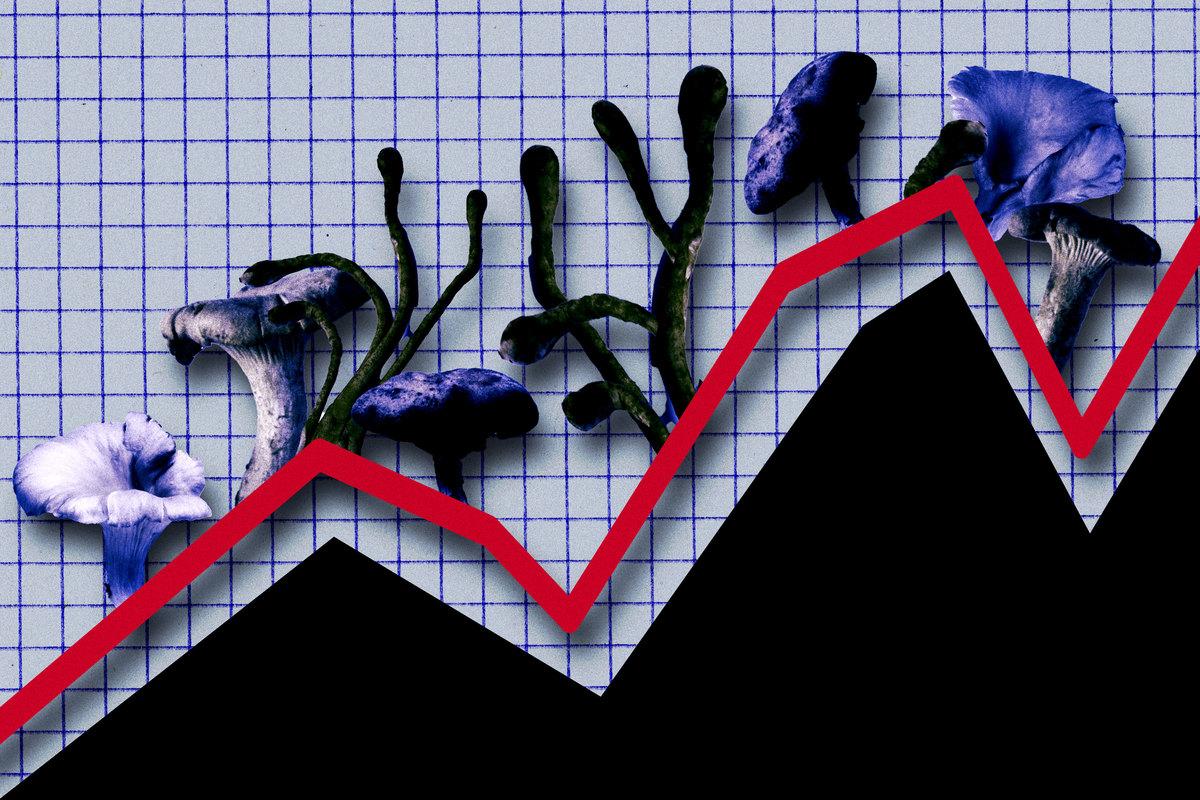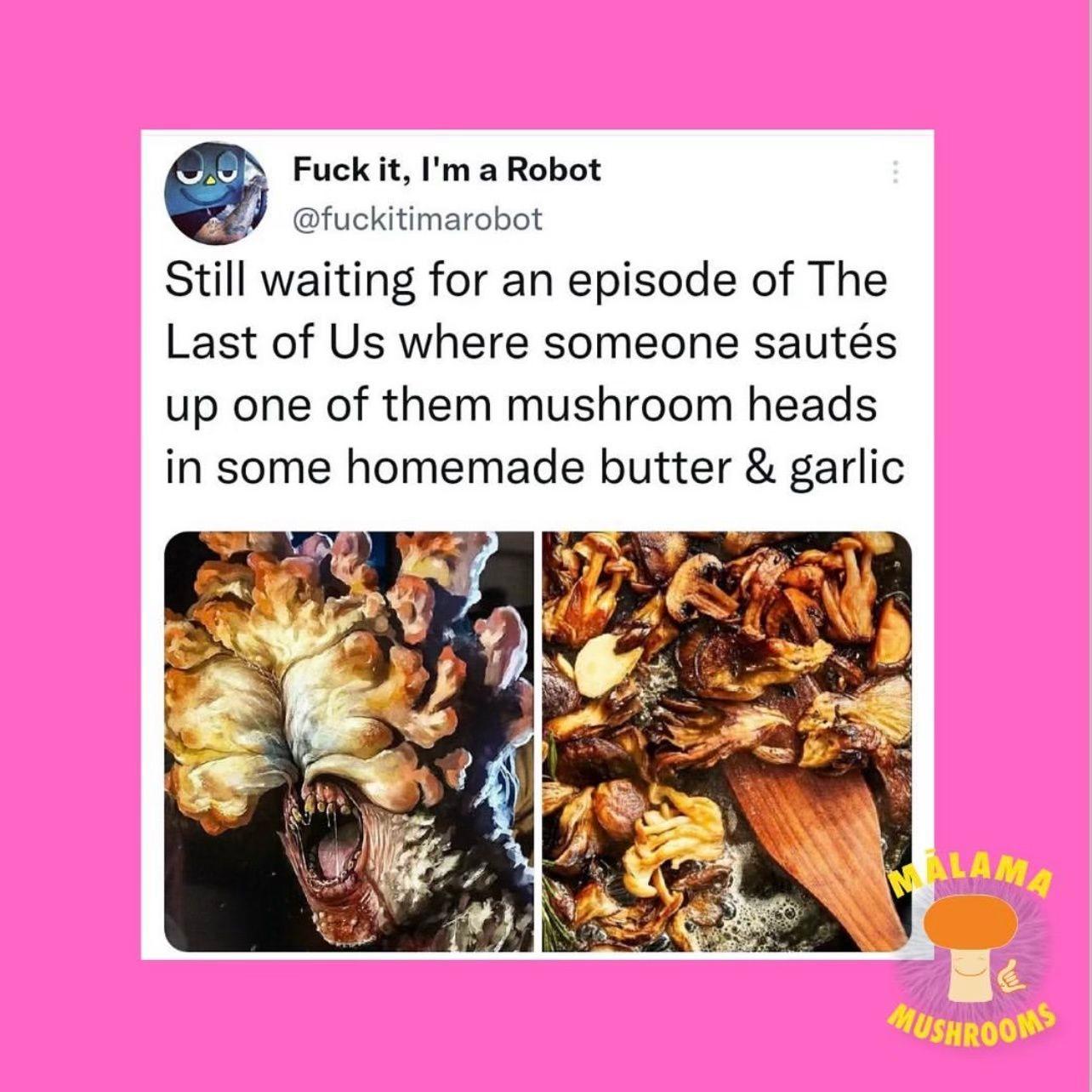
Ben Lillibridge is not what he calls “a show guy.” The 30-year-old business owner based in Kailua-Kona, Hawaii, considers himself “too busy” for binge-watching. He never even touched Game of Thrones.
But so many friends and customers kept telling him to watch The Last of Us this past January that he was forced to make an exception. And when he started the hit HBO series, he was alarmed by what he saw—just not for the same reasons as everybody else.
“I was just watching this zombie attack Pedro Pascal and seeing Cordyceps grow out of dead bodies,” he says with a laugh. “I was like, ‘This is not good PR.’”
Lillibridge is the CEO, founder, and self-described “funguy” of a family-run company called Malama Mushrooms that sells food cut with a variety of mushroom-based health supplements. And it just so happens that Cordyceps—the Cheeto-like fungus that infects and engulfs humanity in The Last of Us—is the main ingredient in one of his product lines: a handful of mixes, chocolates, and powders meant to boost energy, endurance, and respiratory health.
In other words, he’s in the business of convincing people to eat the fruiting body of the very fungus that caused everybody’s new favorite fictional apocalypse. (And when I say everybody, I mean the season’s penultimate episode—in which a twist
ed preacher waxes poetic about how the Cordyceps fungus “secures its future with violence”—drew a series-high 8.1 million viewers.) Though Lillibridge is well-acquainted with the mycological arguments for why the outbreak in the show is unrealistic, he and his employees are navigating the Cordyceps mushroom’s new omnipresence in both their in-person and online customer interactions. “In the past few months, people will either be tongue in cheek, saying, ‘Is this going to turn me into a zombie and make me eat people?’ or seemingly genuinely inquiring, ‘Isn’t this the thing in The Last of Us?’” Lillibridge says.
He’s just one of many mushroom superfood sellers, educators, and influencers who are receiving an influx of frightened, curious, and sardonic inquiries about the zombifying capabilities of their products. Over the last five years, a confluence of venture capital, scientific research, and culinary interest has produced a “shroom boom” that has sunk its spores into everything from fashion to medicinal treatments and has produced a cluster of fungi-centric start-ups. Chief among them is a new generation of health food companies who champion the long-believed medicinal benefits of mushrooms like reishi, lion’s mane, and, yes, Cordyceps. Now, these same fung-evangelists find themselves in a scenario straight out of a shroom trip: A superfood they sell is also the villain in one of the most watched shows in the world. “If The Last of Us is your first context for Cordyceps, obviously that would make you scratch your head when you see a product now selling something that says ‘Cordyceps,’” Lillibridge says.
Now, as these experts and businesses field an onslaught of misinformation from shroom-curious viewers, they’re aiming to capitalize on what may be the biggest pop culture moment in recent history for mushrooms. Using as many debunking videos and zombie memes as they can muster, they hope to take this newfound and widespread public fear of an especially resourceful fungus and cast a universal veil over it—and maybe even get more people invested in this growing subculture.
“I have heard a lot of concerns from major mycologists saying that The Last of Us is myco-phobic propaganda further brainwashing people to be hysterically afraid of mushrooms,” Alex Dorr, the founder and CEO of a health supplement company called Mushroom Revival, wrote to me from a shaky Wi-Fi connection in a boat on the Brahmaputra River in India. “While I get this perspective, I also think it’s a perfect opportunity for us educators to open their minds more about this whole kingdom of life.”
Ironically, Cordyceps mushrooms have been coveted, not feared, for most of modern history. As little as 10 years ago, the only way to get your hands on them in the U.S. was to go foraging in the Rocky Mountains or import them from Asia for up to tens of thousands of dollars per pound. Cordyceps were first mentioned in a 15th-century Tibetan medicinal text titled “An Ocean of Aphrodisiacal Qualities.” Known as yartsa gunbu, which translates to “summer grass, winter worm,” the wild species of the mushroom has been collected on the Tibetan Plateau for centuries. Its origins likely inspired the setting of Indonesia in the opening scene of The Last of Us’s second episode, where a mycologist, played by the excellent Christine Hakim, is brought in to examine a human infected with Cordyceps and subsequently advises a military lieutenant to bomb the city. Unsurprisingly, searches for the term “Cordyceps” spiked in Indonesia around that episode’s air date, according to Google Trends.
For decades, the wild mushroom (Ophiocordyceps sinensis) has been a sought-after status symbol in China, hailed as “the Viagra of the Himalayas” and as a respiratory and energy booster after it was used in the diets of the 1993 Chinese female track-and-field team, whose runners set records in several events. Its rarity is rooted in its long, terrifying, parasitic fruiting process. The fungus infects caterpillars in the fall, consumes their body over the winter, and grows a mushroom from them in early summer. Sensing a larger demand for these mystical mushrooms, farmers adapted a different species (Cordyceps militaris) to be cultivated at scale. Compared to Ophiocordyceps sinensis, it can grow without infecting the corpses of insects, and it contains higher amounts of healthy compounds. Commercial cultivation of the species began to pick up steam in East Asia in the late ’90s and 2000s. “If you travel to, say, Eastern Europe or China, mushrooms are ancient news and have been loved for thousands of years,” Dorr wrote via email. “In the US, the main driver is the adoption of the internet and social media where people around the world can share ideas, culture, content and open our mind to new and old possibilities and paradigms.”
Mycological interests beyond criminis and portobellos began to sprout in the United States in the aughts as passionate advocates like Paul Stamets broke through to larger audiences online. When asked what major mushroom-related pop culture moments came before HBO’s The Last of Us, multiple enthusiasts pointed to Stamets’s 2008 TED Talk, “6 ways mushrooms can save the world,” which has over 8.6 million views. (It apparently also reached the writers of Star Trek: Discovery, who later named an “astro-mycologist” character after Stamets.) The Last of Us video game, which places the original wild Cordyceps at the center of a zombie apocalypse, was released in 2013.
It was only in 2017, after a self-taught mycologist named William Padilla-Brown published a cultivation guide he developed at his “decentralized citizen research effort,” MycoSymbiotics, that Americans were able to figure out a way to grow the mushroom on a larger scale. “He’s responsible for the fact that we basically grow Cordyceps commercially in the U.S.,” Gordon Walker, a mushroom influencer who goes by the handle @fascinatedbyfungi on several platforms, says. Not long after this crucial innovation, an avalanche of Cordyceps by-products descended on American culture. As capsules, gummies, and powders. As Goop smoothie ingredients and meandering Joe Rogan podcast discussions. As a supporting character in Fantastic Fungi, a 2019 Netflix documentary that is, for some reason, narrated by Brie Larson. As the key ingredient of an “endurance” tincture that my runner friend bought at last month’s Los Angeles Mushroom Fair. And then, as the existentially threatening villain in a hit HBO series.
“Pre–Last of Us, there was interest from sort of video game nerds, but it was often kind of like a passing interest,” Walker says. “Now, it’s become this sort of societal phenomenon that everyone is now aware of Cordyceps, becoming interested in slash repulsed by them at the same time.”
As someone who has made it his purpose to espouse mushroom facts to the online masses, Walker has had a front-row seat to the “good and bad in humanity” that comes out when teaching people about mushrooms. The 36-year-old biochemistry PhD (and another self-described “funguy”) began his career as a mushroom educator in 2017. He has since grown his reach to over 2.1 million followers combined across Instagram, TikTok, and YouTube. He says people have very strong “myco-phobic” reactions to his videos, specifically ones of mushrooms that have pores (like a species known as slippery jack) or secrete sweat-like droplets (like the bleeding tooth fungus). Some people have even reported his posts.
“I’ve had people say all sorts of nasty things to me,” Walker, who is based in Napa Valley, says. “I’ve learned that mushrooms are this emotional lightning rod for people.”
At first, Walker thought that if he worked to educate people about why a Cordyceps apocalypse is improbable, he could make people less afraid. But he started to realize something else was at play. “There’s a real divide between the people who are very afraid and then the people who are very disappointed that it’s unrealistic,” Walker says. “Almost all the comments are people refuting what I’m saying, saying, ‘No, but it is possible.’ And it sounds like they actively want this to happen. It’s funny. People have that fantasy about living in an apocalyptic zombie land and going around and taking any food you want, any guns you want, shooting things. It’s a cool idea. But in terms of the science of this, it’s just not realistic.”
Per Walker, his Cordyceps content has earned higher-than-average views and comments than his usual content. And like any good content creator, he’s also poked the bear a bit. In early February, he made a video of himself cooking and eating what he dubbed “the Last of Us fungus,” set to the opening music of the show. “Bring on the zombie apocalypse,” he concludes. “I’ll eat them all.” The top response of over 700 comments on the video is: “Nice knowing you all.”
But this wild level of fascination, even fear, has gone beyond just morbid voyeurism. From a business perspective, Dorr says that Mushroom Revival’s Cordyceps sales have been boosted, not hurt, by the show. “There’s definitely been a spike,” he says. “This is such a shock and attention-grabber that people want to know what the heck we are doing. We definitely have their attention. That’s for sure.”
It seems as though Cordyceps sellers have learned to embrace, not reject, the marketing opportunity HBO has inadvertently given them, even if it does come in the form of lobotomized zombies. “We’re getting those kinds of questions, like, ‘Oh, you know The Last of Us and Cordyceps?’” says Jerry Angelini, head of science education at Host Defense, another mushroom superfood company. “We laugh along with everyone. To us, there’s no such thing as bad press.”
Malama’s Lillibridge has come around to the idea too. His sister, Amanda, has taken to posting winking zombie apocalypse memes on the company’s Instagram to give the people what they want.


“Did Jaws do less for sharks or more for sharks, I wonder?” he asked. “I feel like it probably mostly scared the general public from sharks. But I think it’s cool if it inspires people to revere and think more about mushrooms. Like maybe someone watching, that’s their first time thinking about mushrooms outside of a grocery store context. And then maybe they go down an internet rabbit hole and they’re like, ‘Wow, this thing will give me extra energy.’ And then they try a product and they’re like, ‘Wow, that really works.’ And then they learn, ‘Oh, there’s so many species of Cordyceps, and this one occurs here in my state.’ And then they go have a foraging experience where they actually find it, and they get super excited about mushrooms and become a devoted member of the mushroom army, like me.”
So even as clickers stalk Joel and Ellie every Sunday night, maybe it’s better for most people to fear Cordyceps than to have never heard of it at all.
“It’s a net positive for the fungus among us,” Lillibridge says. “Maybe bad for Cordyceps? But I don’t really care; I’m stoked on the pop culture moment.”
An earlier version of this piece stated that the opening scene of the second episode of The Last of Us took place in Bhutan. The scene took place in Indonesia.
